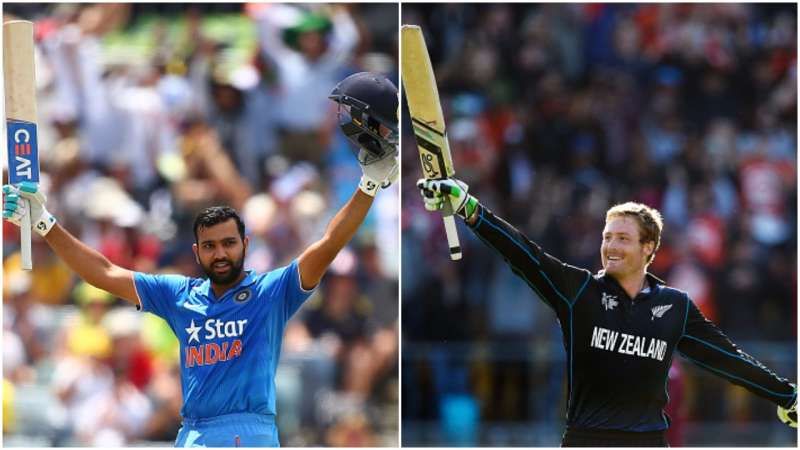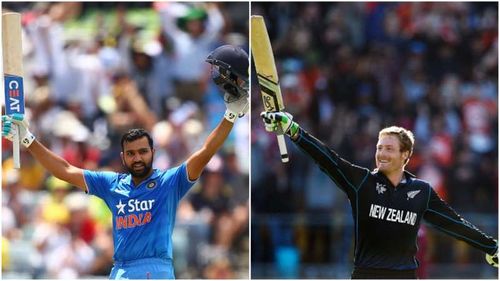
Martin Guptill: New Zealand's answer to Rohit Sharma
Even as the India-New Zealand ODI series moves into the fifth and final match at Vizag tomorrow amidst cyclone concerns, the verdict is already out that the series has been more evenly contested in comparison to the Test matches.
The 2-2 score line is indeed a fair indication that both India and New Zealand have had good and bad days in equal measure and there are no clear favourites. With all to play for, both teams will aim to iron out the chinks identified from the earlier matches and bring out their A-game into the decider. Incidentally, the failure of its opening pair would be top on the list of worries for both.
While Tom Latham has enjoyed a very consistent run at the top of the order, Martin Guptill has failed to build partnerships with him on all occasions, barring the previous match. For India, the pair of Rohit Sharma and Ajinkya Rahane haven’t produced the fluent starts expected of them - either getting out cheaply or consuming too many balls before throwing away their wickets.
In particular, Rohit has had an indifferent series considering his hot form in ODIs earlier in the year – when he aggregated 441 runs from the tour of Australia - and the encouraging signs he showed in Tests, prior to the current ODI series.
Both will need to fire at the top of the order for their respective teams, but that’s not all. There’s a lot in common between these two cricketers and their career progression so far, which should make for interesting reading:
A Common Love for the Big Knocks – The Double Centurions
When Sachin Tendulkar was once asked who among the younger generation of batsmen would carry forward his legacy, the Mumbai maestro had said he would back both Virat Kohli and Rohit Sharma to do it.
While the former is now busy racking up centuries like Sachin and pushing most of his records, the latter has also been walking Sachin’s talk. Until a few years ago, a double century in ODIs was unheard of. Sachin reached there first; Sehwag followed, and then Rohit did, not once, but twice!
Rohit’s first one was the 209 against Australia in Bengaluru’s Chinnaswamy Stadium, which just fell short of Viru’s 219 – then, the highest ODI score. In his second attempt, he scored the enormous 264 against Sri Lanka on his favourite hunting grounds, the Eden Gardens, thus owning the highest ever individual ODI score by a fair distance.
It took close to 40 years of ODI cricket for the first ODI double century to be registered, three more came in another four years, but the 2015 World Cup saw two of them in the space of two months. Chris Gayle and Martin Guptill became the first two double centurions in World Cup history.
Gayle scored 215 against Zimbabwe to become the first double centurion in World Cup history, only to see the latter better his feat and give his team a taste of the same medicine, with a knock of 237 in their Quarterfinal clash.
Equally Explosive Strikers in the Shorter Formats
Both Rohit and Guptill are clean strikers of the ball in the limited-overs formats - a penchant for hitting big sixes unites them. The former is a genuinely talented player who relies on the gift of timing, unless he is playing that powerful front foot pull of his, over the square leg fence. Lazy elegance as they call it, Rohit’s batting - a total sum of perfectly still balance at the crease, a full flow of the bat from a high back-lift and an extra few seconds of time to play the ball - is a pure feast for the eyes.
In contrast, Guptill is your conventional hard-hitting batsman who banks on his power game and goes after the ball with hard hands and exceptional bat speed to send the ball sailing into the stands. While Rohit likes to take his time and get his eye in before capitalising on the start, Guptill prefers to attack from the word go. It should, therefore, come as no surprise that the latter owns the 2nd fastest ODI fifty - fastest by a Kiwi - and the New Zealand record for the 2nd fastest T20I fifty.
So far, Rohit has struck 114 sixes in 152 ODIs, while the latter’s done even better, going over the ropes 118 times in just 133 matches. The uncanny resemblance in their ODI/Twenty20 International records is also not to be missed.
ODI Batting Stats:
| Matches | Innings | NO. | Runs | Highest | Average | Strike Rate | 100s | 50s |
Rohit | 152 | 146 | 23 | 5061 | 264 | 41.14 | 84.18 | 10 | 28 |
Guptill | 133 | 130 | 14 | 4955 | 237* | 42.71 | 86.24 | 10 | 31 |
*Stats at the end of the 4th ODI of New Zealand tour of India, 2016
T20I Batting Stats:
| Matches | Innings | NO. | Runs | Highest | Average | Strike Rate | 100s | 50s |
Rohit | 62 | 55 | 12 | 1364 | 106 | 31.72 | 129.41 | 1 | 11 |
Guptill | 61 | 59 | 7 | 1806 | 101* | 34.73 | 131.44 | 1 | 10 |
Unfulfilled Potential in Test Cricket, Strong Backing from the Team
Both are explosive batsmen in white ball cricket, yet, their exploits so far in Test cricket narrates a different story. Ironically, what works for them in limited overs cricket is exactly what hampers their game in the longest format – technique.
At a time when most bowlers bowl a straighter line in limited overs cricket to deny width to the batsmen, Rohit’s minimal movement at the crease combined with his ability to use his hands rather than reaching the ball with his feet, allows him to judge each ball, adjust his choice of stroke and make his decision to play off the front foot or back foot.
However, the demands of Test cricket are different. Protected by slips and other catchers in attacking positions throughout the day, bowlers do not adopt a defensive line of bowling. Instead, the batsman’s footwork, as well as his patience are put through a severe test by the moving red ball relentlessly bowled in the ‘corridor of uncertainty’ outside the stumps.
Guptill’s natural tendency to go at the ball with hard hands even in Test cricket and his travails against spin bowling are also well documented. What these two have garnered though, is unanimous support from their team managements. Captain Virat Kohli foresees Rohit’s growth as an enforcer in the middle order who could consistently produce those quick-fire pre-declaration knocks that can give the team a better shot at winning Test matches, if he is backed to the hilt. In spite of a poor average stretching over 47 Tests and obvious technical flaws, the Kiwis too back Guptill to eventually grow into a Sehwag or Warner like aggresive role at the top of the order.
Test Batting Stats:
| Matches | Innings | NO. | Runs | Highest | Average | 100s | 50s |
Rohit | 21 | 36 | 4 | 1184 | 177 | 37.00 | 2 | 7 |
Guptill | 47 | 89 | 1 | 2586 | 189 | 29.38 | 3 | 17 |
*Stats till the 3rd Test of New Zealand tour of India, 2016
The Transformation from Inconsistent Starters to Accomplished Limited Overs Batsmen
Both had slow starts to their careers before they went on to become the much-feared batsman that they are now. Guptill made his ODI debut for New Zealand in 2009, but it was after Brendon McCullum assumed full-time duties as the Kiwi captain in 2012 that he blossomed into a destructive opener at the top of the order. The transformation that has happened to him between these phases are clear in the stats below.
Guptill’s ODI Batting Stats before McCullum’s captaincy:
| Matches | Innings | NO. | Runs | Highest | Average | Strike Rate | 100s | 50s |
Guptill | 54 | 52 | 6 | 1751 | 122* | 38.06 | 79.99 | 2 | 12 |
Guptill’s ODI Batting Stats under McCullum’s captaincy:
| Matches | Innings | NO. | Runs | Highest | Average | Strike Rate | 100s | 50s |
Guptill | 56 | 55 | 6 | 2442 | 237* | 49.83 | 93.13 | 5 | 16 |
Likewise, Rohit’s fortunes turned for the better ever since he started opening the innings for India.The first half of his career saw him batting in the middle order and facing constant criticism over his performances getting outweighed by the opportunities he was handed out. He was even an object of several social media trolls which compared his stay at the crease to the taglines of Maggi noodles commercials.
A strike rate in the 70s and an average just over 30 indicates he did not live upto his immense talent in his first coming. However, a tweak in his batting position has seen him shut out all the critics and transform himself into one of the best openers currently in the shorter formats.
Rohit’s stats in other batting positions:
| Matches | Innings | NO. | Runs | Highest | Average | Strike Rate | 100s | 50s |
Rohit | 84 | 79 | 17 | 1967 | 114 | 31.72 | 78.58 | 2 | 12 |
Rohit as an opener in ODIs:
| Matches | Innings | NO. | Runs | Highest | Average | Strike Rate | 100s | 50s |
Rohit | 68 | 67 | 6 | 3094 | 264 | 50.72 | 88.17 | 8 | 16 |
- Stats at the end of the 4th ODI of New Zealand tour of India, 2016
And The List Goes on
The similarities just don’t end here. Both are just a year apart by age - Rohit is 29, while Guptill is 30. They open the innings in the shorter formats. Both are excellent fielders and they even bowl occasional off spin. Guptill scored a century on ODI debut, Rohit emulated the feat on his Test debut.
This year’s IPL even saw both playing in the same team - after going unsold in the auction, the Kiwi turned out for the Mumbai Indians team led by Rohit, as a replacement for the injured Lendl Simmons.
They might be plying their trade for two different countries, but it will be difficult to find another identical pair like them - so similar in style and by stats.
At just around 30, the peak years of both these batsmen are still ahead of them and it will be interesting to see if they can both match each other’s achievements and end with similar magnitude of success, treading their own different paths. If they do, India and New Zealand stand to gain.
